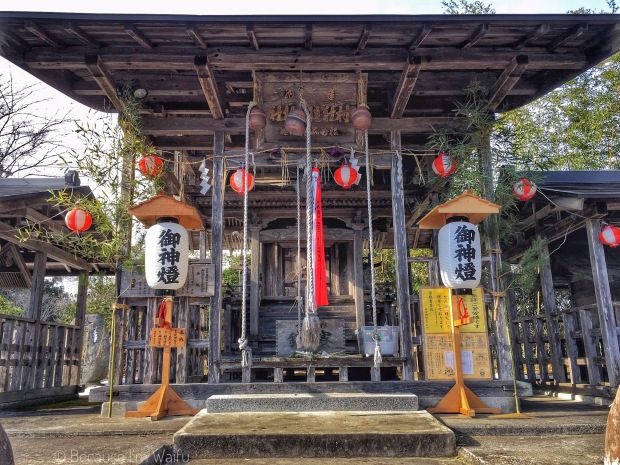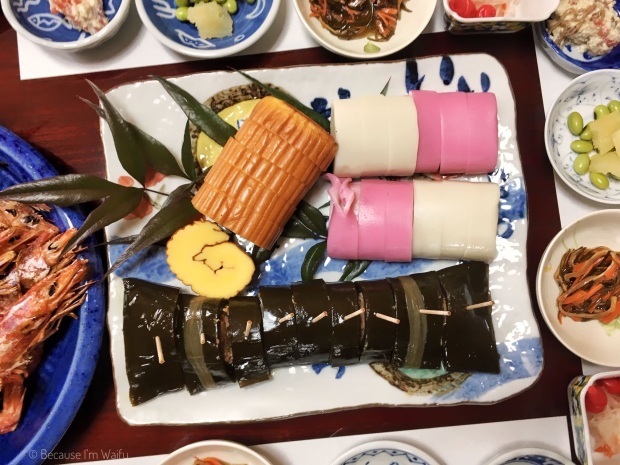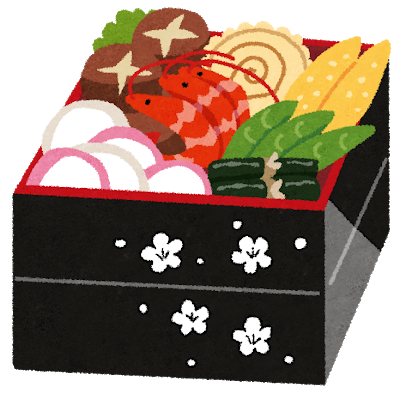New Years is probably the biggest holiday of the year in Japan. Also known as o’shōgatsu (お正月), the celebrations start around December 31st until January 3rd, with most businesses closed during that time. While work is put to a halt, people return to their family home and engage in a variety of interesting traditional customs, many of which I experienced first-hand and documented in my article here.

New Years Day shrine visit
One of those many traditions is eating o’sechi ryōri (おせち料理) the morning of January 1st. O’sechi means ‘New Year’ and ryōri is ‘cuisine’. Thus, o’sechi ryōri is not just a mere one or two special dishes, but as many as 40 dishes!
The food is prepared a couple of days in advance or on New Years Eve, and is later transferred to small dishes for serving. Here is what our o’sechi looked like all spread out for our family of 6 + 1 toddler.

The funny thing is, many Japanese natives have told me that they don’t really like o’sechi food. They’re served cold and the traditional tastes aren’t always so palatable. So there has to be a reason why people still prepare or buy them for New Years. And there is!
Nearly every item you saw pictured above has it’s own symbolic meaning. Let’s explore our 14 o’sechi dishes.
The center dishes
Gobo-maki (ごぼ巻)
Gobo, also known as burdock root, grows into a long stick directly from soil, and is rather hard and fibrous. Thus, in o’sechi, it symbolizes strength and stability. You can prepare it in many ways, but a popular way is gobo-maki.

Maki means roll, so gobo-maki is any food wrapped around a piece of gobo. Here, we have pork-wrapped and chicken-wrapped. Another common one is gobo inside fishcake.
Ebi (エビ)
Ebi, or shrimp, have a bent shape about them. This shape is synonymous with how a person’s back might start to bend as they age. So, the shrimp symbolizes longevity, wishing that you can live as long as possible without a bent back!

Simply grilling them on the pan is popular. For o’sechi, large prawns are eaten.
Datemaki (伊達巻), Kouhaku kamaboko (紅白蒲鉾), Konbu-maki (昆布巻)
Datemaki is a sweet rolled omelette that contains some fish paste. It’s golden in color and looks and tastes like a fluffy sponge cake. It’s said to mimic a traditional scroll, thus symbolizing knowledge.
Kouhaku kamaboko are red (rather, pink) and white fish cakes. Red is supposedly a talisman against evil, while white is for purity, a good way for your soul to enter into the new year.

Datemaki (left), Kouhaku kamaboko (right), Konbu-maki (bottom)
Konbu-maki is made up of kelp seaweed (konbu), wrapped around another food such as salmon. Ours is wrapped around buri (鰤) or grilled yellowtail, symbolizing a successful life. Konbu itself is said to symbolize joy and good omens.
Extra: what are those red berries?
You might have noticed that the above three dishes are decorated with something extra. This plant is called nanten (ナンテン), or sacred bamboo, commonly grown in Japanese gardens. Its kanji means “a bit of difficulty” (難点). In o’sechi, it’s likely a wish that you don’t experience many big hardships in the new year. Or because it’s cut from the shrub, it means to pluck away your hardships.
The small dishes
Apart from the above three dishes, the rest of o’sechi is served in small plates for each individual, and should be set up in a specific order. We’ll go over them row by row, left to right.

Top row
(1) Namasu (なます) – pickled daikon and carrot dish. The red carrot and white daikon mirror water droplets in a pool, said to symbolize peace and happiness. Make it at home–> recipe.
— In the same dish: Chorogi (ちょろぎ) – very sour and crunchy Chinese artichoke tubers pickled red by shiso leaves. Written as 長老喜, it means to live a long life.
(3) Kazunoko (数の子) – very salty, salt-preserved herring roe eggs with green mame. The pouch of eggs symbolizes prosperity for all your descendants.
(2) Matsumaezuke (松前漬け) & (4) Shiroae (白和え) are not o’sechi foods. The first is a traditional tsukemono or pickled dish, from Matsumae. The colors of shiroae are similar to namasu and may hold similar meanings.
Middle row
(1) Rencon (れんこん) – lotus root contains many holes, which might make you think of poor luck (easy for stuff to fall through). By eating it, it symbolizes better luck in future prospects.
(2) Kuri kinton (栗きんとん) – my favorite all dishes is this sweet treat made of candied chestnuts and sweet potato paste. Its bright golden color symbolizes wealth. Want to make it yourself? (Yes) –> recipe.
(3) Kuromame (黒豆) – these sweet black beans symbolize working diligently.
Bottom row
(1) Nimono (煮物) – Typically, o’sechi are prepared in 4 or 5 tiered boxes, with one filled with nimono, or simmered dishes. They include rencon, gobo, satoimo, konjaku, takenoko, and more. Satoimo (taro) represents lasting prosperity to your descendants, while takenoko (bamboo shoots) mean advancing in life. Konjaku that come in a twist either refer to bonds (i.e. relationship ties) or an old battle proverb about mental focus.
(2) O’zōni (お雑煮) -a soup traditionally eaten by samurai but now commonly for New Years. It’s not part of o’sechi, but many ingredients are. Ours contained an abundance of gobo, konyaku, takenoko, and rencon.
(3) Kōyadofu (高野豆腐) – non-o’sechi food, just very yummy. (: Soft spongy tofu filled with minced meat.
Not pictured: Tai (鯛) or red snapper – “tai” is found in the word medetai (めでたい), meaning prosperity.

What will you be having next New Years?
—
-Waifu ʕ•ᴥ•ʔ
